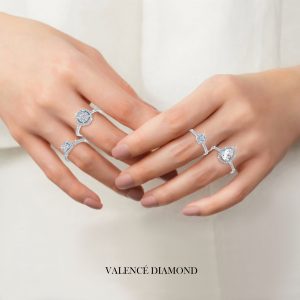THE JOURNEY OF THE DIAMONS IN THE OTTOMAN EMPIRE
When looking at the records of 1526, it is noted that there were 90 jewelers in the service of the sultans. This indicates the significant importance of jewelry in the Ottoman era. In the Ottoman Empire, jewelry was not only used in adornments but also featured in opulent designs on everyday items such as bookshelves, kitchen utensils, and weapons.
The style of jewelry used in the Ottoman period generally consisted of natural designs. Rather than symmetrical cuts, there was a greater emphasis on working with precious metals while preserving the natural shapes of the stones. These pieces were typically produced in special workshops within the palace and saw an increase with the expansion of the Ottoman Empire’s borders. By the 18th century, Ottoman designs began to show Western influences, leading to the use of larger and more striking pieces of jewelry.
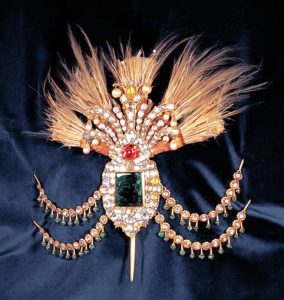
AIGRETTE: The Ornamental Headpiece of Ottoman Royalty
Aigrette referred to the feathered and jeweled adornments used in the headgear of the sultan and the significant women of the Harem. These ornaments, often designed in the shapes of flowers and water droplets, were also given as valuable gifts by the sultans to esteemed individuals. Prominent women in the Harem typically wore these adornments in sets of three: two on the head and one on the outfit. The aigrettes worn by women were usually designed to rest over the forehead, above the hairline.
Topkapı Palace and the Treasury
In the Ottoman palace, the most important examples of diamonds are found in the Treasury Department of Topkapı Palace. Topkapı Palace was not only the administrative center of the Ottoman Empire but also a place where rich treasures, jewels, and diamonds were displayed. These diamonds were significant items used in the daily lives of sultans and palace members, worn on special occasions, and given as diplomatic gifts.
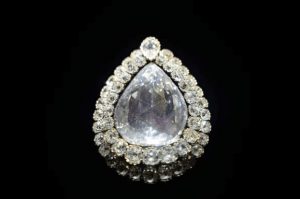
The Spoonmaker’s Diamond
One of the most famous diamonds in the Ottoman Empire is the “Spoonmaker’s Diamond” displayed in Topkapı Palace. Weighing 86 carats, this diamond is among the largest and most valuable diamonds in the world. According to legend, this diamond was found by a spoonmaker in a marketplace and traded for spoons. It was later brought to the Ottoman palace, where it was crafted into one of the most valuable pieces in the treasury.
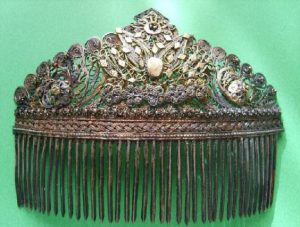
Use of Jewelry Among Women in the Ottoman Palace
The use of earrings was quite prevalent among the women of the palace. They often preferred drop-shaped designs that hung downwards. Care was taken to ensure these earrings matched the color of their outfits and the style of their hair.
Long-designed necklaces were also commonly used by the women of the palace. Like the earrings, the necklaces often featured dangling designs.
Flower and geometric-patterned belt buckles adorned with diamonds, rubies, and emeralds were also used by the high-ranking women of the Harem. These models, worn around the waist and hips, were favored jewelry pieces of the palace women for centuries.
Beyond accessories, jewelry was also crafted onto many everyday items. Combs designed with jewels were among the items used by the upper-class women of the palace.
Diamond Craftsmanship and the Grand Bazaar
The Grand Bazaar in Istanbul is known as the center of diamond craftsmanship. Here, Ottoman jewelers worked on raw diamonds brought from India, transforming them into unique pieces of jewelry. Ottoman jewelers combined traditional techniques and artistry with modern innovations, revealing the natural beauty of the diamonds.
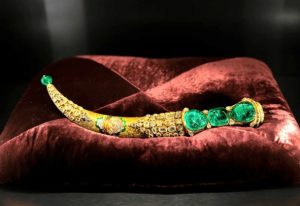
Symbolic Value of Diamonds
In the Ottoman Empire, diamonds were not only ornamental objects but also symbols of power and prestige. Diamond jewelry worn by sultans and palace members signified their status and authority. Additionally, the purity and durability of diamonds were accepted as symbols of love and eternity. Therefore, diamond jewelry held a significant place, especially in engagement and wedding ceremonies.
Transition to the Modern World
For centuries, there were many jewelers brought to the palace from beyond the expanding borders by the sultans. These jewelers generally consisted of experts in jewelry. In their designs, these craftsmen often incorporated examples from nature, which contributed to the creation of a unique spirit in the jewelry used during the Ottoman period. We can frequently observe motifs such as flowers, water droplets, bees, butterflies, and birds in jewelry designs. The place of more detailed and flawless designs has been replaced by a simpler and larger approach due to the growing interest in the West.
After the Ottoman Empire, these magnificent diamonds and jewelry were preserved as heritage and passed on to the modern world. Today, some of the Ottoman diamonds are exhibited in museums, while others are kept in private collections. The jewelry art of the Ottoman Empire continues to be a source of inspiration in craftsmanship and design even today.
